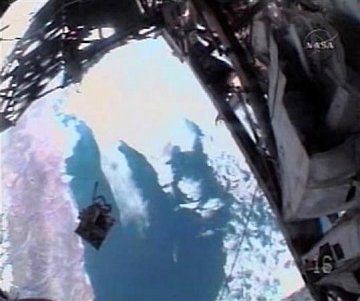From the Hubble telescope
The Long View
The stars, WR 25 and Tr16-244, at the bottom of the image, are located within the open cluster Trumpler 16. At the top of the image, a peculiar nebula with the shape of a "defiant" finger points towards WR25 and Tr16-244.
These 3 stars were thought to be just one big star, 7,500 light years from earth, but the Hubble telescope was able to see the three separate bodies of intense burning hydrogen. The Trumpler 16 cluster has some of the hottest, fast burning stars in the known universe.
They can meow at the same time. Harmony, maybe?
And this from http://spaceweather.com
Tool Bag In The Sky
ISS TOOLBAG: When Endeavour astronaut Heidemarie Stefanyshyn-Piper dropped her toolbag during a spacewalk on Nov. 18th and it floated away, mission controllers probably thought they'd seen the last of it. Think again. Amateur astronomers have been monitoring the backpack-sized toolbag as it circles Earth not very far from the International Space Station. (continued below)

Above: NASA TV footage of the runaway toolbag.
After sunset on Nov. 22nd, Edward Light saw the bag using 10x50 binoculars as it sailed over his backyard in Lakewood, New Jersey. "It was quite a favorable 70-deg pass in clear skies," he says. "The visual magnitude of the bag was about +6.4 plus or minus half a magnitude." On the same night, Keven Fetter of Brockville, Ontario, video-recorded the bag zipping past the 4th-magnitude star eta Pisces: 900 kB movie. "It was easily 8th magnitude or brighter," says Fetter.
This week the toolbag is making a series of passes over Europe; late next week it will return to the evening skies of North America. Using binoculars, look for it flying a few minutes ahead of the ISS. Spaceweather's satellite tracker is monitoring both the space station and the tool bag; click here for predictions.
Speaking of the Space Station
The International Space Station
In 1984, I read a theory suggesting a global atmospheric fire might occur as a result of 2 or 3 simultaneous nuclear detonations or meltdowns. All the air on Earth would burn away in brief but devastating fireball engulfing the planet.
We were in the process of building a space station, back then, and I imagined the people in the space station watching the Earth burn away below and realizing they were marooned. I wrote a song about it.
Over the years, I sometimes sing that song and some people that have heard it, actually request it.
As some of you know, I have been songwriting and recording with a fellow musician who lives in Glasgow. I write a bit, record it and e-mail an mp3 to Paul. He adds to the song and sends it back to me. This works both ways. He sends me a song he has written, I add to it, and so on.
Just for fun, I recorded my old Space Station One song and sent it to him. He liked it, added some parts, and started writing additional songs from the space station. To say that it was inspiring would be an understatement. Songs from the different people and sections of the ship have been pouring out of me as fast as I can do them. The same thing is happening to Paul, over in Scotland. We are amassing more than enough material to make an album with this theme.
It doesn't stop there. As I write, the characters are becoming defined in my imagination. At first, they are all overwhelmed by the probability that they will soon run out of food and air and the future looks short and deadly. But the songs have almost been writing themselves, and some of the newer peoples songs have faith and hope.
It seems that the more I write this, it is also becoming a libretto for an opera or musical. At least it was yesterday, but I woke up tonight and began writing a letter from one of the women to her husband back on Earth! She has discovered that she is pregnant, and if they can find ways to survive long enough, it will be the first baby born in space.
Here's the deal; Because of my recent interest in fullerene research, I can imagine a couple of the science officers devising a way to separate and collect the carbon molecules from the carbon dioxide, releasing oxygen back into the air in the space station, and using the caged carbon molecules to construct whatever equipment they may need. Like a food synthesizer. They could combine molecules from waste with fullerenes to manufacture food.
Now that I have these guys living indefinitely, it's time they figure out how to capture and use other objects in orbit as more living quarters or what ever the satellites have to offer. On and on it goes. Now it's a novel and a TV series, and a movie.
Meanwhile, the songs seem to keep on writing themselves.
Listen to what we have so far;
Papa Paul Thomas
Happy Phil Seymour

No comments:
Post a Comment